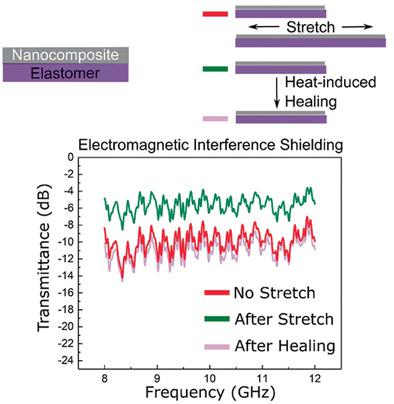当前位置:
X-MOL 学术
›
Adv. Electron. Mater.
›
论文详情
Our official English website, www.x-mol.net, welcomes your feedback! (Note: you will need to create a separate account there.)
Graphene–Polyurethane Coatings for Deformable Conductors and Electromagnetic Interference Shielding
Advanced Electronic Materials ( IF 6.2 ) Pub Date : 2020-08-16 , DOI: 10.1002/aelm.202000429 Pietro Cataldi 1 , Dimitrios G. Papageorgiou 1, 2 , Gergo Pinter 1 , Andrey V. Kretinin 1 , William W. Sampson 1 , Robert J. Young 1 , Mark Bissett 1 , Ian A. Kinloch 1
Advanced Electronic Materials ( IF 6.2 ) Pub Date : 2020-08-16 , DOI: 10.1002/aelm.202000429 Pietro Cataldi 1 , Dimitrios G. Papageorgiou 1, 2 , Gergo Pinter 1 , Andrey V. Kretinin 1 , William W. Sampson 1 , Robert J. Young 1 , Mark Bissett 1 , Ian A. Kinloch 1
Affiliation

|
Electrically conductive, polymeric materials that maintain their conductivity even when under significant mechanical deformation are needed for actuator electrodes, conformable electromagnetic shielding, stretchable tactile sensors, and flexible energy storage. The challenge for these materials is that the percolated, electrically conductive networks tend to separate even at low strains, leading to significant piezoresistance. Herein, deformable conductors are fabricated by spray‐coating a nitrile substrate with a graphene–elastomer solution. The electrical resistance of the coatings shows a decrease after thousands of bending cycles and a slight increase after repeated folding‐unfolding events. The deformable conductors double their electrical resistance at 12% strain and are washable without changing their electrical properties. The conductivity–strain behavior is modeled by considering the nanofiller separation upon deformation. To boost the conductivity at higher strains, the production process is adapted by stretching the nitrile substrate before spraying, after which it is released. This adaption meant that the electrical resistance doubles at 25% strain. The electrical resistance is found sufficiently low to give a 1.9 dB µm−1 shielding in the 8–12 GHz electromagnetic band. The physical and electrical properties, including the electro magnetic screening, of the flexible conductors, are found to deteriorate upon cycling but can be recovered through reheating the coating.
中文翻译:

用于可变形导体和电磁干扰屏蔽的石墨烯-聚氨酯涂层
致动器电极,顺应性的电磁屏蔽,可伸缩的触觉传感器和灵活的能量存储需要导电的聚合材料,即使在很大的机械变形下也能保持导电性。这些材料的挑战在于,即使在低应变下,渗透的导电网络也趋于分离,从而导致显着的压阻。在这里,可变形导体是通过用石墨烯-弹性体溶液喷涂丁腈基底来制造的。涂层的电阻在经过数千次弯曲循环后会降低,而在反复发生折叠-展开事件后会略有增加。可变形导体在12%的应变下其电阻增加了一倍,并且可以在不改变其电性能的情况下进行清洗。通过考虑变形时纳米填料的分离来模拟电导率-应变行为。为了提高较高应变下的电导率,可通过在喷涂前拉伸丁腈基材,然后释放丁腈基材来调整生产过程。这种适应性意味着电阻在25%的应变下会翻倍。发现电阻足够低以提供1.9 dB在8-12 GHz电磁频带中的µ m -1屏蔽。发现柔性导体的物理和电气性能(包括电磁屏蔽)在循环时会变差,但可以通过重新加热涂层来恢复。
更新日期:2020-09-08
中文翻译:

用于可变形导体和电磁干扰屏蔽的石墨烯-聚氨酯涂层
致动器电极,顺应性的电磁屏蔽,可伸缩的触觉传感器和灵活的能量存储需要导电的聚合材料,即使在很大的机械变形下也能保持导电性。这些材料的挑战在于,即使在低应变下,渗透的导电网络也趋于分离,从而导致显着的压阻。在这里,可变形导体是通过用石墨烯-弹性体溶液喷涂丁腈基底来制造的。涂层的电阻在经过数千次弯曲循环后会降低,而在反复发生折叠-展开事件后会略有增加。可变形导体在12%的应变下其电阻增加了一倍,并且可以在不改变其电性能的情况下进行清洗。通过考虑变形时纳米填料的分离来模拟电导率-应变行为。为了提高较高应变下的电导率,可通过在喷涂前拉伸丁腈基材,然后释放丁腈基材来调整生产过程。这种适应性意味着电阻在25%的应变下会翻倍。发现电阻足够低以提供1.9 dB在8-12 GHz电磁频带中的µ m -1屏蔽。发现柔性导体的物理和电气性能(包括电磁屏蔽)在循环时会变差,但可以通过重新加热涂层来恢复。



























 京公网安备 11010802027423号
京公网安备 11010802027423号